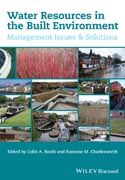
Water management is a key environmental issue in controlling of floods and reducing droughts. This book provides analysis of the main issues, offering solutions and describing good practice. Water Resources for the Built Environment: management issues and solutions develops an appreciation of the diverse, complex and current themes of the water resources debate across the built environment, urban development and management continuum. The integration of physical and environmental sciences, combined with social, economic and political sciences, provide a unique resource, useful to policy experts, scientists, engineers and subject enthusiasts. By taking an interdisciplinary approach, water resources issues and impacts on the built environment are presented in the inventive and strategic setting of considering the constraints of delivering potable water to an ever–demanding society who, at the same time, are increasingly aware of living in an urban landscape where excessive surface water creates a flood threatened environment – hence, the need to portray a balance between ‘too little vs. too much’. This unique approach to the water resources debate presents a multifaceted collection of chapters that address the contemporary concomitant issues of water shortage and urban flooding and proffers solutions specifically for the built environment. The book is structured into three parts: the first part (Sections 2, 3 and 4) addresses management issues and solutions to minimise water shortages and provide water security for society; whilst the second part of the book (Sections 5 and 6) addresses management issues and solutions to control excessive rainfall and minimise flooding impacts. The third part (Section 7) contextualises the issues of the earlier sections within international case studies from the developing world. INDICE: Section 1: Introduction to the Book 1 Water Resources: Balancing Too Little Versus Too Much Section 2: Water Demand, Policy and Cost 2 Meeting Demand: Water Strategy, Policy and Legislation 3 Water Privatisation and Regulation: the UK Experience 4 Urban Water Economics Section 3: Water Infrastructure and Supply 5 Impacts and Issues of Dams and Reservoirs 6 Powering the Water Industry 7 Water Quality and Treatment 8 Desalination 9 Delivering and Designing for Potable Water in Buildings Section 4: Water Conservation Strategies 10 Water Neutrality – An Overview 11 Building Regulations for Water Conservation 12 Rainwater Harvesting – Reaping a Free and Plentiful Supply of Water 13 Greywater Harvesting – Reusing, Recycling and Saving Household Water 14 Inland Waterway Systems – A Solution to Drought and Flooding Issues Section 5: Flooding Responses and Reinstatement 15 Urban Precipitation: Measurements, Monitoring and Processes 16 Urbanisation and Stormwater 17 River Flood Defences and Flood ‘Prediction’ 18 Coastal Flood Defences – Strategies for Protection in the UK 19 The Costs of Flooding on Households 20 The Role of Market Based Flood Insurance in Maintaining Communities at Risk of Flooding: A SWOT Analysis 21 Holistic Property–level Flood Protection Section 6: Flood Solutions in the Urban Landscape 22 Sustainable Drainage Systems – Features and Designs 23 Drainage Benefits of Porous, Permeable and Pervious Paving 24 Multiple Benefits of Green infrastructure 25 Constructed Wetlands for Wastewater Management 26 Wastewater Treatment Infrastructure and Design Section 7: International Case Studies 27 An Overview of Management Issues in Developing Sustainable Water Supply, Sanitation and Hygiene (WASH) Service Delivery in Nigeria 28 Balancing the Flood Risk and Water Scarcity Issues of the Asian Delta Regions Section 8: Summary of the Book 29 Water Resources Challenges – Penury and Peace Index
- ISBN: 978-0-470-67091-0
- Editorial: Wiley–Blackwell
- Encuadernacion: Rústica
- Páginas: 432
- Fecha Publicación: 03/03/2014
- Nº Volúmenes: 1
- Idioma: Inglés
